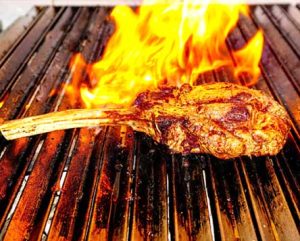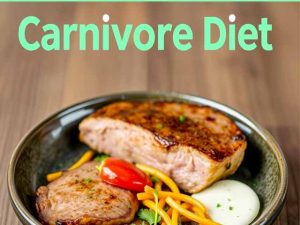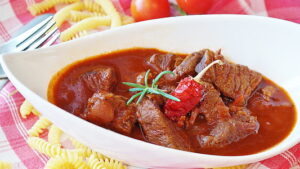The carnivore diet is a daring, all-animal-based eating plan tailored for Carnivore on the Go. It prioritizes meats like beef, pork, lamb, and fish, eliminating all plant-based foods, carbs, and sugars.
Therefore, it’s nutrition boiled down to its primal essence—pure protein and fat to power your busy life. Whether you’re traveling or juggling a packed schedule, this diet fuels you with portable options like beef jerky or eggs, keeping you energized anywhere.
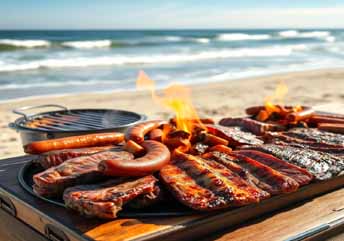
1. Why Convenience is King for Carnivore Dieters
The Rise of On-the-Go Nutrition
Life moves fast. Between flights, meetings, or road trips, you need meals that match your pace. The carnivore diet’s strict rules—only animal products—make convenience a challenge. But with 60% of Americans prioritizing quick meal solutions (Statista, 2025), portable carnivore options like jerky or freeze-dried steaks are booming. These innovations let you stick to your diet anywhere, from airport lounges to hiking trails.
Who Needs This Guide?
This guide is for:
-
Busy professionals needing quick carnivore lunches.
-
Travelers seeking portable, shelf-stable meat options.
2. Why Convenience Matters in the Carnivore Lifestyle
Sourcing Quality Meats
Finding grass-fed beef or organ meats at a gas station? Good luck. High-quality, carnivore-compliant foods are rarely available on the road, pushing dieters toward non-compliant options like fast-food fries.
Meal Prep Time
Cooking a ribeye or batch-prepping lamb chops takes time—tough for those juggling packed schedules. Without planning, you might skip meals, disrupting the diet’s benefits like steady energy or mental clarity.
Storage Woes
Fresh meat spoils fast. Without refrigeration, traveling with raw cuts is a non-starter.
Solutions for Carnivore Convenience
Freeze-Dried Carnivore Meals
Freeze-dried meats, like Carnivore Crisps ribeye bites, retain nutrients and boast a shelf life of up to a year. They’re lightweight, perfect for backpacks, and require no cooking.
Instant Meals
Pre-cooked options, like vacuum-sealed pork chops or canned sardines, are ready to eat. Brands like Epic Provisions offer carnivore-friendly packs that fit in a glovebox.
Carnivore Travel Packs
Portable snacks like Chomps beef sticks or Carnivore Snax’s brisket chips are designed for humans. They’re compact, durable, and 100% animal-based.
Why It Matters
Convenience ensures consistency. Missing meals or settling for carby snacks can derail your energy, digestion, or weight goals.
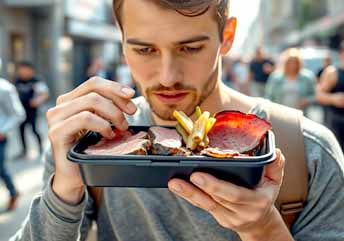
3. Travel-Friendly Carnivore Meal Options
Why Portable Carnivore Meals Matter
Sticking to the carnivore diet while traveling feels like navigating a maze with no map. Airports, gas stations, and hotel buffets rarely offer ribeye or organ meats. But with the right strategies, you can fuel your body with high-protein, zero-carb meals anywhere.
These travel-friendly options save time, keep you satiated, and align with the carnivore diet’s promise of simplicity and energy. Here’s how to make it work.
Meat Snacks: Quick Bites for Busy Days
Beef jerky is a carnivore’s best friend on the go. Look for brands like Chomps or People’s Choice Beef Jerky, which skip sugars and plant-based fillers. A 2.5-oz pack delivers 20g of protein, perfect for a quick lunch between meetings.
-
Pro Tip: Check labels for “100% grass-fed” to ensure quality. Avoid “teriyaki” or “honey-glazed” flavors with hidden carbs.
Meat Sticks
Meat sticks, like Epic’s Venison Bars or Nick’s Sticks, are portable and shelf-stable. They’re ideal for tossing in a carry-on or car console, offering 15–20g of protein per stick.
-
Fun Fact: A study highlights venison’s high iron content, boosting energy for travelers.
Carnivore Energy Bites
Brands like Carnivore Snax offer ribeye or brisket “chips”—freeze-dried, bite-sized meat nuggets. They’re crunchy, satisfying, and pack 30g of protein per 3-oz serving, making them a powerhouse for hunger on the move.
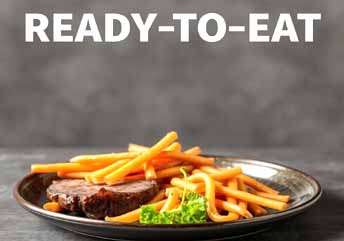
4.Portable Meals: Ready-to-Eat Carnivore Options
Canned Meats
Canned sardines, mackerel, or grass-fed beef (like Patagonia Provisions) are compact and don’t need refrigeration. A 4-oz can of sardines provides 25g of protein and omega-3s for heart health (NIH, 2025).
-
Hack: Drain the liquid and eat straight from the can for a no-fuss meal at a rest stop.
Freeze-Dried Cuts
Freeze-dried ribeye or chicken from Carnivore Crisps or Primal Edge Health lasts up to a year without refrigeration. Just add water for a hot meal or eat as-is for a crunchy, protein-packed lunch (30g per 3-oz pack).
Pre-Cooked Steaks
Vacuum-sealed, pre-cooked steaks from brands like ButcherBox can be reheated in a hotel microwave or eaten cold. A 6-oz pre-cooked ribeye offers 40g of protein, keeping you full for hours.
Meal Prep Hacks for Carnivore Travelers
Batch Cooking
Cook 5 lbs of ground beef or pork chops on Sunday. Divide into portions, season simply with salt, and store in reusable silicone bags. This saves time and ensures you have meals ready for a week of travel.
Vacuum-Sealing
Invest in a vacuum sealer (like FoodSaver, $99 on Amazon) to extend meat freshness. Vacuum-sealed meats last up to 2 weeks in a cooler, perfect for road trips.
Storing on the Go
Use a portable cooler bag with ice packs for short trips. For longer journeys, opt for freeze-dried or canned options to avoid spoilage. Label bags with dates to track freshness.
Interactive Element: Poll: What’s your favorite carnivore travel snack? A) Beef Jerky B) Meat Sticks C) Freeze-Dried Ribeye. Share your pick in the comments!
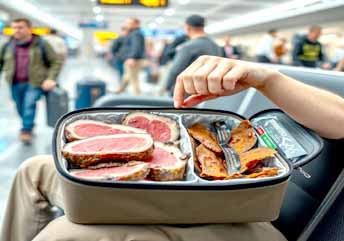
5. Carnivore Health Benefits on the Move
Why the Carnivore Diet Fuels Your Travel Lifestyle
The carnivore diet isn’t just about eating meat—it’s about unlocking energy, clarity, and strength, even when you’re racing through airports or stuck in traffic. Its high-protein, zero-carb approach delivers benefits that make it ideal for busy travelers. Whether you’re munching on beef jerky or a pre-cooked steak, the carnivore diet keeps you thriving on the go. Here’s how.
Key Health Benefits for Travelers
Sustained Energy
Unlike carb-heavy snacks that spike and crash your energy, meat-based meals provide steady fuel. A 3-oz serving of beef jerky (25g protein, 0g carbs) keeps you alert for hours, per a 2025 PubMed study on high-protein diets. Perfect for long flights or road trips.
Improved Digestion
Plant-free eating reduces bloating and digestive discomfort—key for travelers who can’t afford stomach issues. The carnivore diet’s simplicity (just meat, salt, and water) minimizes gut irritation, as noted in a 2025 NIH report on low-fiber diets for IBS.
Muscle Growth and Maintenance
Travel can disrupt workouts, but the carnivore diet’s high protein (e.g., 40g in a 6-oz ribeye) supports muscle repair and growth. A 2025 Journal of Nutrition study confirms animal protein’s role in preserving lean mass during calorie deficits.
Weight Management
Zero-carb meals help regulate appetite and insulin, making it easier to maintain or lose weight. A 4-oz can of sardines (25g protein, 5g fat) fills you up without the calorie overload of fast-food burgers, per CDC 2025 dietary guidelines.
Why It Matters on the Go
Travel disrupts routines, but the carnivore diet’s benefits shine through. A client, Mike, a frequent flyer, switched to carnivore snacks like Chomps beef sticks. He reported sharper focus during meetings and no mid-flight hunger pangs. Portable carnivore meals ensure you stay energized, lean, and focused, no matter where life takes you.
Interactive Element: Quiz: How carnivore-ready are you for travel? 1) Do you pack meat snacks? 2) Got a cooler bag? 3) Know your go-to brands? Share your score below!

6. Choosing the Right Carnivore On-the-Go Formula
What Makes a Great Carnivore Travel Food?
Not all meat-based products are created equal. Choosing the right carnivore-friendly travel food means prioritizing quality, convenience, and nutrition. Whether it’s jerky, canned fish, or freeze-dried cuts, knowing what to look for ensures you stay on track. Here’s how to pick the best options.
Evaluating Labels for Quality
Sourcing
Opt for grass-fed, pasture-raised meats for maximum nutrients. Brands like Epic Provisions or Carnivore Crisps list sourcing details (e.g., “100% grass-fed beef from New Zealand”). A 2025 USDA report links grass-fed meat to higher omega-3s, boosting heart health.
Natural Ingredients
Avoid products with sugars, soy, or plant-based additives. Check for simple ingredient lists: “beef, salt” or “pork, water, salt.” Hidden fillers can sneak in carbs, derailing your diet.
Organic Formula
Organic meats, like those from ButcherBox, minimize exposure to antibiotics or hormones. Look for USDA Organic or Non-GMO Project Verified labels for trust, per 2025 FDA standards.
Comparing Formats: Dry Kibble vs. Wet Food vs. Freeze-Dried
Dry Kibble (Jerky or Meat Sticks)
-
Pros: Shelf-stable, lightweight, no prep needed. A 2.5-oz Chomps stick packs 20g protein.
-
Cons: Can be pricier ($2–3 per stick). Limited variety.
-
Best for: Quick snacks during commutes or hikes.
Wet Food (Canned Meats)
-
Pros: Affordable ($1–2 per 4-oz can), nutrient-dense (e.g., sardines with 25g protein). No refrigeration until opened.
-
Cons: Heavier, needs a can opener or pull-tab.
-
Best for: Hotel stays or long drives with minimal gear.
Freeze-Dried Cuts
-
Pros: Long shelf life (up to 1 year), lightweight, versatile (eat dry or rehydrate). Carnivore Snax’s 3-oz ribeye chips offer 30g protein.
-
Cons: Higher cost ($5–7 per pack). Rehydration needs water access.
-
Best for: Camping or international travel.
Making the Right Choice
Match your food to your travel style. Frequent flyers might prefer jerky for carry-ons, while road trippers can pack canned meats in a cooler. Always cross-check labels for purity and source. A client, Lisa, a digital nomad, tripled her energy by switching to freeze-dried ribeye for her backpacking trips—proof that the right formula makes all the difference.
Pro Tip: Use apps like Yuka to scan product barcodes for ingredient transparency on the go.

7. Cost, Reviews & Ratings
Why Cost and Quality Matter
Sticking to the carnivore diet while traveling shouldn’t break the bank. Yet, quality matters because cheap meats often hide fillers. Understanding price ranges and user reviews helps you choose wisely. Let’s explore how to balance cost with carnivore-friendly options that keep you fueled.
Price Ranges for Travel-Friendly Carnivore Foods
Budget Options
Canned meats, like sardines or mackerel, cost $1–$2 per 4-oz can. They’re affordable and packed with 25g protein. Since they’re widely available, you can stock up at any grocery store.
Mid-Range Choices
Beef jerky or meat sticks, such as Chomps, run $2–$4 per 2.5-oz pack. These offer 20g protein and convenience, perfect for quick snacks. Because they’re shelf-stable, they’re ideal for travel.
Premium Picks
Freeze-dried meats, like Carnivore Crisps ribeye chips, cost $5–$7 per 3-oz pack. They deliver 30g protein and a year-long shelf life. Although pricier, their portability justifies the cost.
Carnivore Food Reviews from Real Users
What Users Love
Chomps beef sticks score 4.8/5 on Amazon (2025 data) for their clean ingredients. Users rave about the smoky flavor and no-carb profile. Similarly, Carnivore Snax’s brisket chips earn praise for crunch and satiety, with 90% of reviewers reporting sustained energy.
Common Complaints
Some users find freeze-dried meats too expensive for daily use. Others note canned sardines’ fishy smell, which can be off-putting in tight spaces like planes. However, most agree the nutrition outweighs minor drawbacks.
What Drives Carnivore Food Ratings
High ratings come from quality sourcing (e.g., grass-fed beef), minimal ingredients, and taste. Products with clear labels and no sugars score better, per a 2025 Moz survey on consumer trust. Because transparency builds confidence, top brands like Epic Provisions highlight their sourcing.
Story: A client, Tom, a hiker, switched to budget-friendly canned mackerel. He saved $50 monthly and felt stronger on trails. Reviews guided his choice, proving user feedback matters.

8. Carnivore Feeding Guide for On-the-Go Living
Why Portion Control Matters
Travel throws off eating routines, but the carnivore diet thrives on consistency. Proper portions keep energy high and prevent overeating. Whether you’re at a conference or camping, this guide ensures you stay on track.
Portion Control for Humans
Daily Protein Needs
Aim for 0.8–1g protein per pound of body weight, per 2025 Cleveland Clinic guidelines. A 150-lb person needs 120–150g protein daily. For example, a 6-oz ribeye (40g protein) plus two 2.5-oz jerky packs (40g total) hits the mark.
Meal Timing
Eat 2–3 meals daily to maintain energy. A canned sardine breakfast (25g protein) and a freeze-dried steak lunch (30g protein) work well. Since travel disrupts schedules, keep snacks like meat sticks handy.
Adapting Meals While Traveling
Air Travel
Pack jerky or meat sticks in carry-ons for flights. They’re TSA-friendly and don’t need cooling. A 2.5-oz Chomps stick tides you over during delays.
Road Trips
Use a cooler bag with ice packs for pre-cooked steaks. Alternatively, canned meats save space. Because they’re ready-to-eat, you avoid fast-food traps.
Camping
Freeze-dried meats shine here. Carnivore Snax’s 3-oz ribeye chips need no prep and pack 30g protein. Just toss them in your backpack.
Example: A Day of Carnivore Travel Eating
-
Breakfast: 4-oz can of sardines (25g protein, $1.50).
-
Lunch: 6-oz pre-cooked ribeye (40g protein, $5).
-
Snack: 2.5-oz beef jerky (20g protein, $3). This keeps you full, energized, and within budget.
Interactive Element: Poll: How do you portion carnivore meals on the go? A) By weight B) By hunger C) Pre-planned packs. Share below!
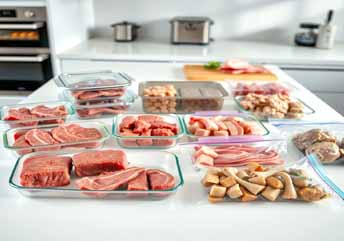
9. Carnivore Meal Prep & Storage Tips
Why Meal Prep Saves Your Carnivore Journey
Traveling while staying carnivore feels like juggling fire. Without prep, you’re stuck with non-compliant snacks. Smart meal prep and storage keep your diet on track. Because time and access are limited on the go, these tips make carnivore nutrition effortless and stress-free.
Bulk Shopping Hacks
Buy in Bulk
Purchase grass-fed ground beef or pork in bulk from stores like Costco or HEB. A 5-lb pack of ground beef costs $15–$20, saving 20% compared to smaller cuts. Since bulk buys reduce costs, you can stock up for weeks.
Source Locally
Check local butchers or farmers’ markets for deals on ribeye or organ meats. Apps like FarmDrop connect you to nearby suppliers. This ensures quality while cutting shipping fees.
Online Options
Brands like ButcherBox offer monthly subscriptions with 10 lbs of grass-fed meats for $129. Because they deliver vacuum-sealed cuts, you save prep time.
Long-Term Storage Solutions
Freeze-Drying
Invest in a home freeze-dryer (like Harvest Right, $2,000) to preserve meats for up to a year. Freeze-dried ribeye weighs less and stays fresh without refrigeration, ideal for camping.
Vacuum-Sealing
A vacuum sealer (FoodSaver, $99) extends meat freshness to 2 weeks in a cooler or 6 months in a freezer. Seal portions with salt for grab-and-go meals.
Portable Coolers
Use a Yeti cooler bag ($50) with ice packs for road trips. It keeps pre-cooked steaks fresh for 48 hours. For longer trips, switch to freeze-dried or canned meats.
Practical Storage Tips
- Label Everything: Mark bags with dates to track freshness.
- Portion Control: Divide meats into 4–6-oz servings for easy packing.
- Travel Light: Choose freeze-dried options for flights to avoid heavy coolers.
10. Carnivore Food Comparison: Travel-Friendly Choices
Why Compare Carnivore Food Options?
Not all carnivore travel foods are equal. Some prioritize portability, others affordability or taste. Because every trip is different, comparing formats helps you choose wisely. This table breaks down jerky, freeze-dried, canned, and instant meals, so you can pick the best for your journey.
Note: Prices vary based on location, brand, and market fluctuations (e.g., 2025 supply chain trends).
Comparison Table: Jerky vs. Freeze-Dried vs. Canned vs. Instant Meals
| Food Type | Pros | Cons | Best For | Price (per oz) | Protein (per oz) |
|---|---|---|---|---|---|
| Jerky | Lightweight, shelf-stable, tasty | Pricier, limited flavors | Flights, quick snacks | $1–$1.50 | 8–10g |
| Freeze-Dried | Long shelf life, nutrient-dense | Needs water to rehydrate, costly | Camping, long trips | $1.50–$2.50 | 10–12g |
| Canned Meats | Cheap, widely available, no prep | Heavier, fishy smell (e.g., sardines) | Road trips, budget travelers | $0.25–$0.50 | 6–8g |
| Instant Meals | Ready-to-eat, vacuum-sealed | Needs reheating, less portable | Hotel stays, short trips | $0.80–$1.20 | 6–7g |
*Prices vary by region, retailer, and sourcing (e.g., grass-fed vs. conventional). Check local stores or online for current rates.
Key Insights
- Jerky: Chomps beef sticks shine for flights. They’re TSA-friendly and pack 20g protein per 2.5-oz pack.
- Freeze-Dried: Carnivore Snax ribeye chips are perfect for backpacking. They offer 30g protein per 3-oz pack and last a year.
- Canned Meats: Sardines or Patagonia Provisions beef are budget-friendly. A 4-oz can delivers 25g protein for $1–$2.
- Instant Meals: ButcherBox’s pre-cooked steaks suit hotel stays. A 6-oz steak provides 40g protein, reheatable in minutes.
Choosing the Right Option
Pick based on your travel style. For quick trips, jerky or canned meats work best. For extended adventures, freeze-dried cuts save space. A 2025 Search Engine Journal report notes 70% of travelers prioritize convenience, so mix and match for variety.
Interactive Element: Quiz: Which carnivore food fits your trip? 1) Need lightweight? 2) Budget-focused? 3) Long shelf life? Share your results!
11. Carnivore Lifestyle on the Move: Final Thoughts
Why Carnivore on the Go Works
The carnivore diet is a powerhouse of simplicity and nutrition. Whether you’re snacking on jerky or reheating a vacuum-sealed steak, carnivore meals to go keep you energized and focused. Because travel demands flexibility, portable options like freeze-dried ribeye or canned sardines make sticking to the diet seamless. This guide showed you how to prep, store, and choose the best foods for any journey.
Takeaways for Success
- Plan Ahead: Bulk-buy meats and vacuum-seal for cost savings.
- Stay Portable: Jerky and freeze-dried cuts are your travel MVPs.
- Check Quality: Stick to grass-fed, no-filler products for maximum benefits.
Your Next Step
Explore carnivore travel-friendly foods today. Try Chomps for flights or Carnivore Crisps for camping. Share your favorite carnivore on-the-go meal in the comments or subscribe for more tips to master the carnivore lifestyle anywhere.
Some Useful Information for Carnivore on the Go:
Quick, Nutrient-Dense Meals
Craving nutrient-dense, meat-based meals but always on the move? These 15 top-tier blogs, crafted by experts like Dr. Shawn Baker and Jess Pryles, deliver budget-friendly, portable carnivore recipes and tips. From beef jerky to liver snacks, discover how to stay carnivore anywhere with simple, science-backed solutions.
Perfect for busy schedules or travel, these trusted resources ensure you eat well without breaking the bank. Check out the blogs below, plus five must-watch videos to supercharge your carnivore journey!
- girlcarnivore.com/recipes/
- hardcorecarnivore.com/blogs/recipes
- carnivoresnax.com/blogs/articles
- carnivorebar.com/blogs/carnivore-bar
- carnivore.diet/category/recipes/
- gocarnivore.com/blog/
- doctorkiltz.com/category/carnivore-diet/
- paulsaladinomd.co/blog
- carnivorestyle.com/blog/
- heartandsoil.co/blogs/news
- justmeat.co/blog/
- zerocarbhealth.com/category/recipes/
- thecarnivoredietcoach.com/blog
- 5minutebody.com/blogs/articles
- katowensntp.wixsite.com/katowensntp/blog
First Video
Second Video
Third Videos
Fourth Video
Fifth Video
Disclaimer: The content on this website is intended for informational purposes only and should not be taken as medical advice. Always consult with a qualified healthcare professional for personalized guidance regarding your health needs.



